Meet the team behind the hugely popular Critter of the Week show and some of the gnarly creatures it has highlighted. By Mike Dickison
It’s Friday afternoon, and radio host Jesse Mulligan is contemplating a fungus beetle. “I’m going to ask you, Nicola, to rate the attractiveness of this beetle on a scale of one to 10.”
Forest & Bird magazine
A version of this story was first published in the Winter 2023 issue of Forest & Bird magazine.
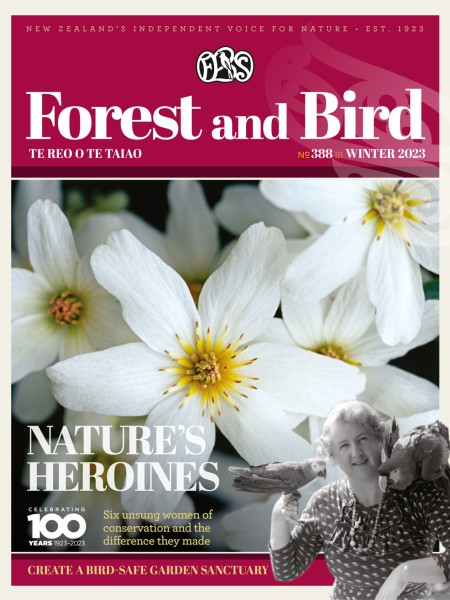
Nicola Toki pauses. “On the basis that it looks like salted caramel chocolate, I’m going to bump it up to a four.” And another episode of Critter of the Week on RNZ Afternoons draws to a close.
Every week since 2015, Jesse and Nicola have discussed a different New Zealand species on the radio, paying special attention to our obscure and overlooked flora and fauna. Every critter – animal, plant, or fungus – is scored by attractiveness (some get very low scores indeed), and more than 300 have had their 15 minutes of fame.
Nicola, who started as DOC’s Threatened Species Ambassador and is now head of Forest & Bird, champions species that are little known, often critically endangered, and aren’t the target of nature documentaries or corporate sponsorships. No bank or dairy company is going to fund saving the Open Bay Islands land leech.
Critter of the Week editors Mike Dickison, Marshall Clark, and Tamsin Braisher collaborate on the strap-toothed whale article at Wellington Wikicon, in March 2023. Image Stephen A’Court
Behind the easy-going rapport of Jesse and Nicola, Critter of the Week is a hive of activity. A researcher is trying to find interesting information about this week’s species, scientists are being grilled about their pet projects, photos are donated from amateur naturalists, and volunteer Wikipedians are working furiously to make sure each critter has a decent online article in time for Friday’s show.
Back in April 2015, I was the natural history curator at Whanganui Regional Museum and was interviewed by Jesse Mulligan about the lack of funding for the unattractive, obscure endangered species of Aotearoa compared with kākāpō and takahē.
This might have planted a seed. Later that year, Jesse was interviewing Nicola Toki about corporate sponsorship of bird conservation and was plainly frustrated: “But what about the earwig?” he demanded.
Nicola, perked up, went off-script: instead of kiwi and takahē, she said, they should be talking about the robust grasshopper! Or the long-jawed galaxias! Smeagol the gravel maggot! And so Critter of the Week was born on 2 October 2015.
Mercury Islands tusked wētā Motuweta isolate. Image Chris Winks
Today, researcher Lily Duval has the tough job of finding and researching a new critter each week, and there are gentle arguments behind the scenes: Is this bird too charismatic for the show? Have we already covered this? Luckily, this is easily checked as volunteers maintain a huge Wikipedia list of every species mentioned on Critter and when it aired.
Back in 2015, I was a big fan of the show but noticed some of these critters were very obscure, so obscure there was almost nothing about them online. If someone was intrigued by the twin-sailed salp or giant wētā fungus and searched for more information, they might find a very sketchy Wikipedia article or none at all.
As a volunteer Wikipedia editor at the time, I started trying to improve the article about each week’s critter – adding references, expanding the conservation status, and linking to the radio show.
All the content in Wikipedia is freely licensed so anyone can use it for any purpose, including the photos. But in New Zealand everyone’s photos are copyrighted All Rights Reserved by default.
I spent a lot of time persuading people to donate a photo to the public domain, under an open licence, so there would be at least one photo of each species that Wikipedia could use for the Critter articles.
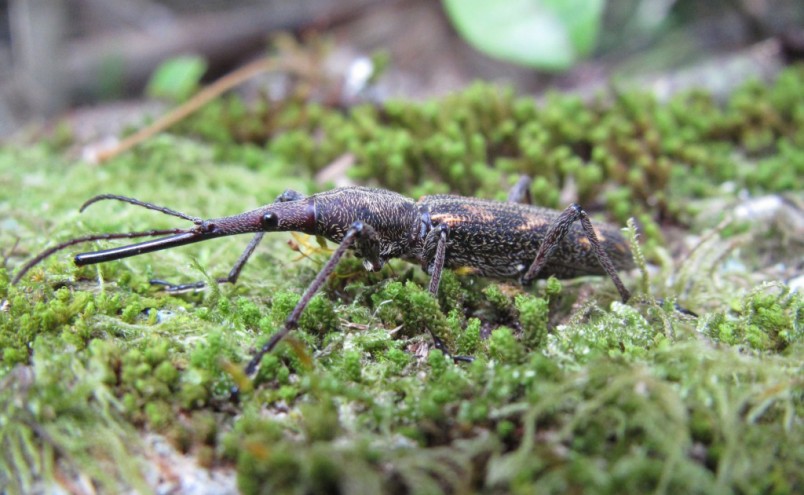
Female Lasiorhynchus barbicornis NZ giraffe weevil. Image Christina Painting
For example, Chrissie Painting is an ecologist who has worked on the bizarre giraffe weevil – a species whose males have enormously elongated snouts. She donated some lovely photographs of males jousting over mates from her field work, fact-checked the Wikipedia article, and left detailed notes and references on the article’s Talk page, something most experts have no idea they can do.
Creating or improving articles each week became addictive, and I learned a huge amount in the process. For example, every living Mercury Island tusked wētā is descended from a male and two females that were rescued and bred in captivity just before they went extinct in the wild.
The Mercury Islands were repopulated with tusked wētā, and the species was saved – a conservation success story but one most people had never heard of until Nicola and Jesse talked about it on Critter of the Week.
I began recruiting a team of Wikipedia volunteers to help share the load, and now every week the dozen people on Team Critter – affectionately dubbed “the wikinerds” by Jesse – get an email the day before the show airs, with a list of article improvements to make.
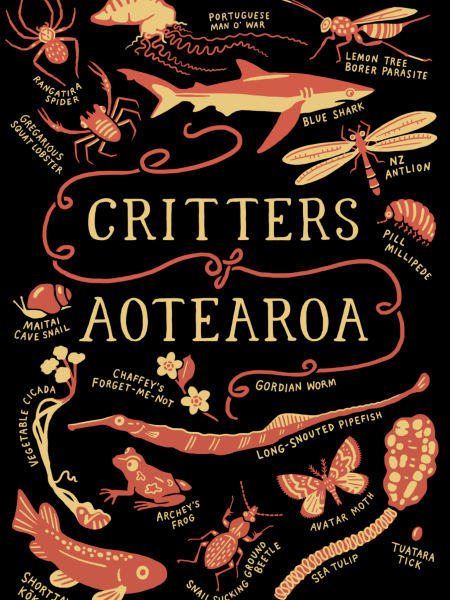
The 2022 Critter of the Week t-shirt designed by Giselle Clarkson.
If there’s no article at all, we scramble to make one. Sometimes, to our dismay, Nicola decides she’ll talk about an entire group, such as cicadas (39 species in New Zealand!). All of which, after much work, now have at least a basic article.
Meanwhile, Critter of the Week has gone from strength to strength. The show regularly draws
100,000 listeners. Cartoonist Giselle Clarkson was adopted as unofficial artist, and each year she creates Critter T-shirts and tea towels. There’s also been a Knit-a-Critter competition and the Great Critter Bake-Off.
Nicola also maintains the show has also been good for Forest & Bird: “It gets me out of trouble when I have difficult meetings with stakeholders,” she explains. “Someone will say ‘We’re really annoyed about your stance on this issue (grumble, grumble) but we do love to listen to Critter of the Week.’”
So far, the show has covered almost all New Zealand’s freshwater fishes and most of the lesser-known birds. But advances in molecular biology mean we know lizard species are being discovered faster than they can be featured on the show.
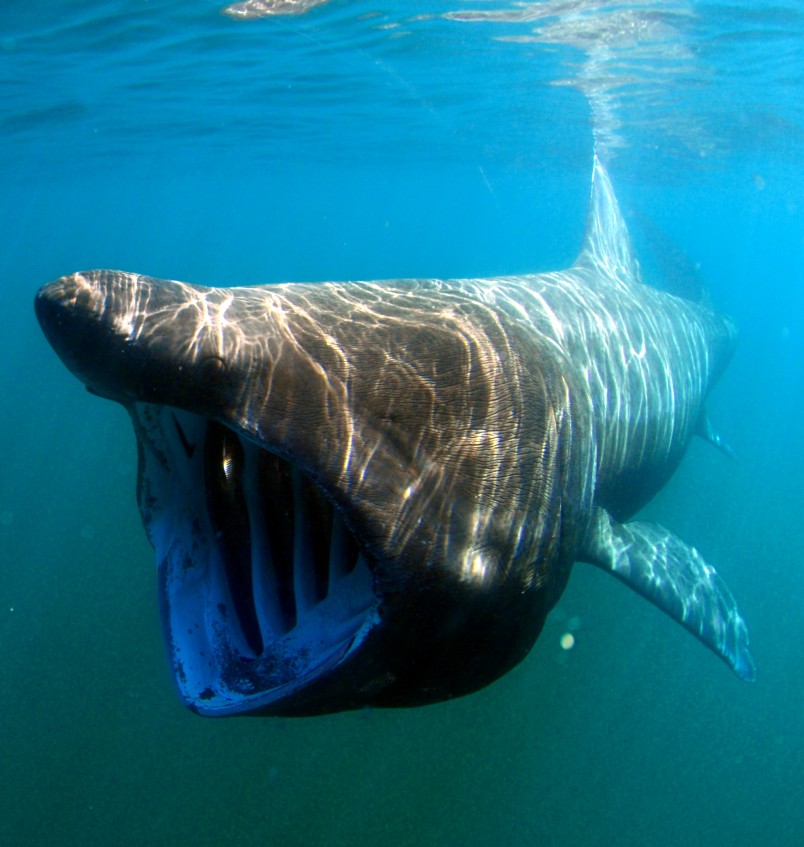
The basking shark Cetorhinus maximus was featured on the show in 2020. Image Greg Skomal
With insects, Jesse and Nicola have barely scratched the surface. They’ve tackled a few of our many species of endangered forget-me-nots, four lichens, two slime moulds, and a single liverwort, leech, centipede, and millipede.
A volunteer might suggest the show cover an obscure liverwort, but do botanists know anything this species – enough for Nicola to talk about it for 15 minutes? For thousands of New Zealand species, all we know is just a Latin name and where they’ve been collected, and thousands more don’t even have that.
So there’s plenty of space for the forgotten species of New Zealand to have their time in the spotlight, at least for another 300 episodes.
Mike Dickison was Curator of Natural History at Whanganui Regional Museum before becoming New Zealand Wikipedian-at-Large in 2018. Since then, he has worked as a Wikipedia consultant for Otago University, Te Papa, NZ Opera, and the Dodd Walls Centre.
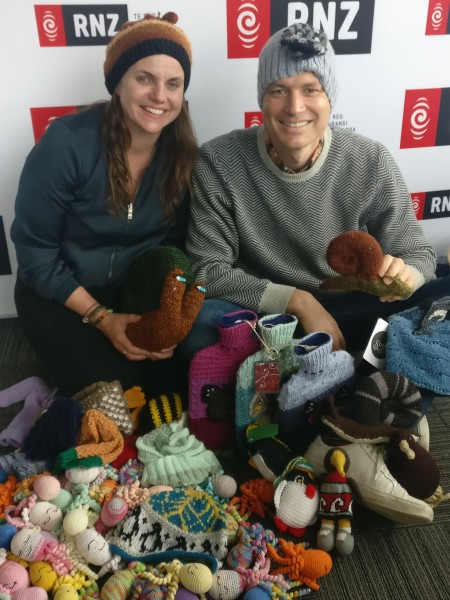
Nicola and Jesse with some of the Knit-a-Critter competition entries. Image supplied
HOW CAN YOU HELP?
Become a volunteer Wikipedia editor and help improve articles about New Zealand’s natural history each week. You could link each article to its RNZ Critter episode, add better photos, or expand the text using published sources. If you like writing and library research, there are plenty of jobs to do!
Donate high-quality photos to Wikipedia – it needs plant, insect, or bird photographers willing to donate some of their images to the public domain. Your photo could end up being used all over the world, and it’s a great way to showcase Aotearoa New Zealand’s unique flora and fauna.

